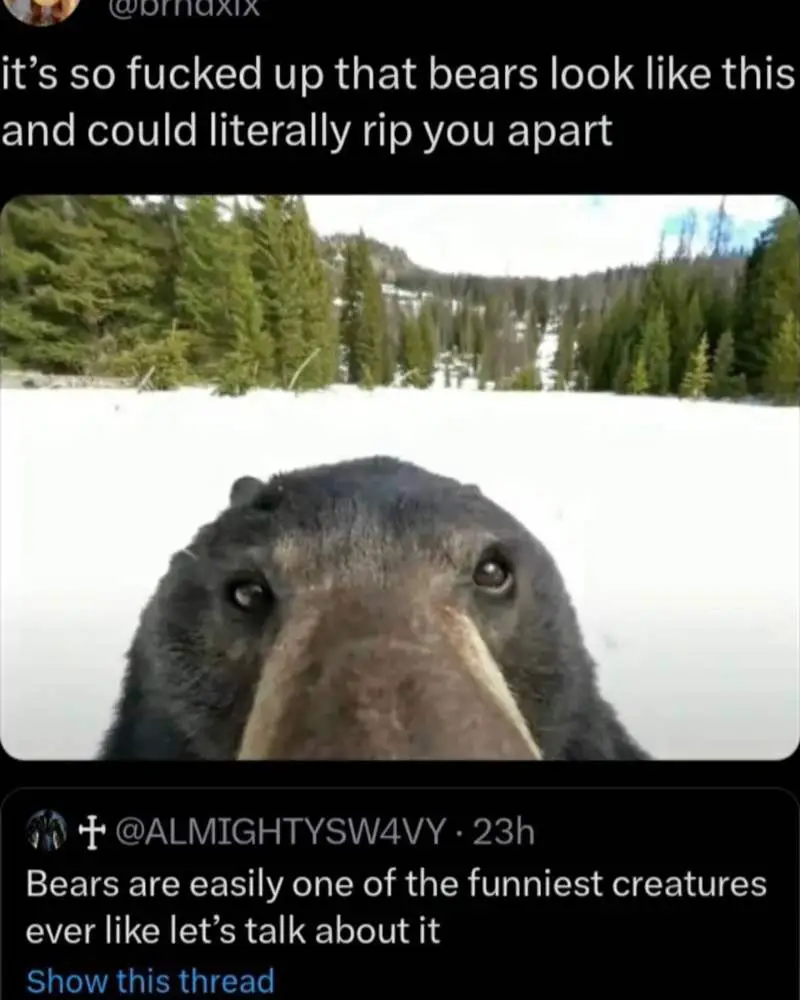It’s The Bear! by Jez Albrough is one of our daughter’s favourite picture books. She loved it when she was three, and still loves it even though she is now seven. It’s The Bear! is the second of Jez Alborough’s three hugely successful bear books from the 1990s. Published in 1996, It’s The Bear came out two years after the first one, and two years before the final book in the series.
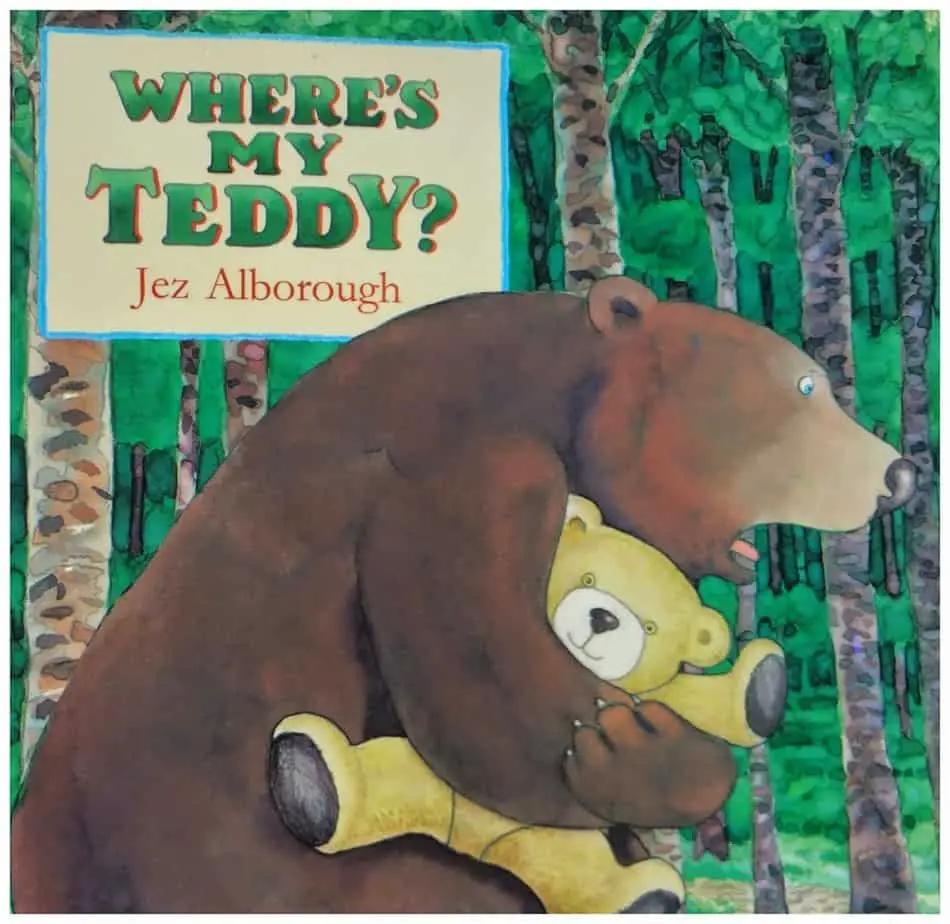
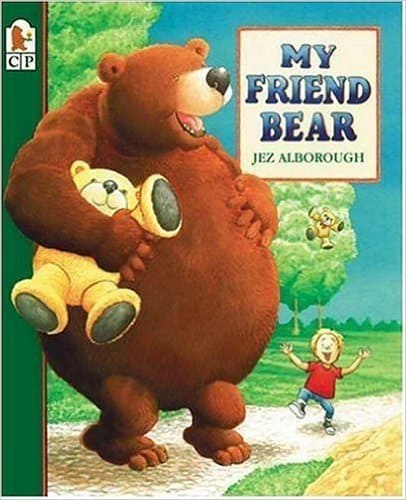
WHAT HAPPENS IN IT’S THE BEAR!
A boy learns not to trust his mum. At least, that’s what our seven-year-old concluded upon our most recent reading. “Eddy’s mum should listen to him!” she said. Basically, a mother takes her son for a picnic in the woods.
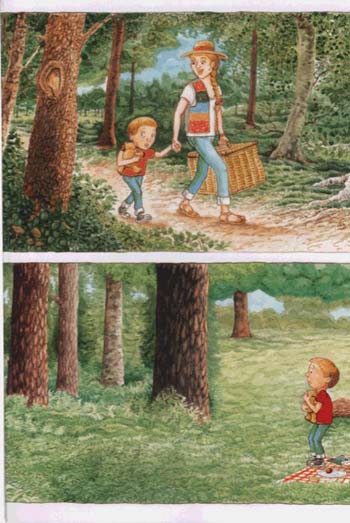
They set out the picnic but mum has to duck back to the car to get a blueberry pie which she has forgotten. While she’s away, an enormous bear arrives, despite her earlier reassurances that there are ‘no bears around here’. The bear is a benevolent creature, however, who only wants to eat the picnic, not the humans. The mother gets a huge, comical fright when she turns around to find that her preschooler son is telling the truth about the existence of a bear.
WONDERFULNESS OF IT’S THE BEAR!
SUSPENSE AND TIMING
Like ancient tales such as Little Red Cap, in which the story is designed to be ‘performed’ rather than read, and in which the child audience grows deliciously scared at the point where the wolf eats the grandma up, this story has a theatre quality to it that will have young listeners cuddling up to their adult co-reader.
This is achieved, of course, by building up suspense. The marketing copy itself lets us know at exactly which point the turning point occurs:
The last time Eddie went for a walk in the woods, he had the biggest surprise of his life! There was a bear the size of a house in there! Now Eddie’s mom is in the mood to picnic in the wood—and she insists there aren’t any bears in there, (except Eddie’s teddy, Freddie). But when Mom forgets the blueberry pie, she runs home to get it while Eddie waits in the woods all alone! [TURNING POINT] What happens next? Just guess! Hold on to your teddies, because Jez Alborough is back with another hilarious story about little Eddie and that oversized bear—and this time he’s hungry!
First we have the set up, in which Mum denies the existence of a bear. Therefore, the experienced reader (and any young reader upon second reading) knows that a bear is definitely coming. This in itself builds suspense.
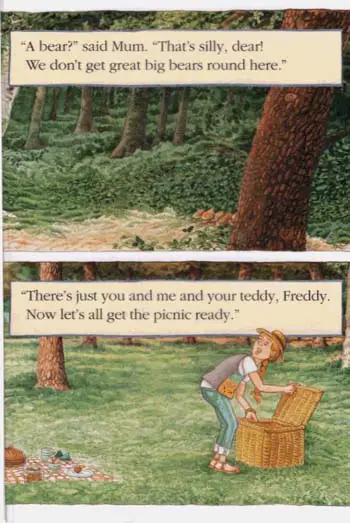
Most of the story is spent on the build up. We see four images of Eddy sitting on the picnic hamper — by the fourth image he is climbing inside to hide.
The following page shows us the first glimpse of the bear. We see Eddy’s eyes as he looks in fright out of the hamper, and we’re sure the bear can see him too.
The page after that is mostly black, and we see Eddy inside the hamper — a top-down view. This mirrors an earlier page in which both Eddy and Mum are looking into the hamper together. We have the same framing of the hamper — the first time we were from the perspective of the food and the large frame was white. This time we see Eddy, and link him to food — Eddy IS the food.
The reader wonders if the bear is going to squash the hamper, but he doesn’t. He (or she) sets up their own teddy bear and ‘greedily gobbles up all of the food’. The small size of the sandwich and plate emphasise the hugeness of the bear.

Take note how many separate illustrations depict the large bear’s realisation that there’s probably dessert in the hamper and actually opening it up. A more economical but far less suspenseful way to illustrate this would have been to show a single illustration (one of any of those shown here). What makes this a picture book rather than an illustrated story is the extra frames.
Notice also that the bear is, despite his size, a child character. We’re to assume he is scared of what’s inside the hamper as Eddy is scared of what’s outside it. One clue: the bear picks up his own teddy as comfort before looking inside — foreshadowing his reaction.
The next two spreads, which readers are to fully enjoy, include between 3 and 5 words each. “Help! shouted Eddy. I want my Mum!”
Adroit framing builds the story for the next big enjoyable surprise: Eddy and Bear have already had their confrontation, now it’s mum’s turn to jump out of her skin. We see her in the distance, but the illustration is framed by the bear’s massive furry leg. Another scene shows her walking closer, with a big smile on her face and a blueberry pie balanced for the taking on her hand, waiter-style. For visual interest, the big bear’s toy teddy is included in this frame.
The following illustration shows how smug and disbelieving the mother is, and allows the bear time to snatch the pie, which seems to be offered to him, after all:
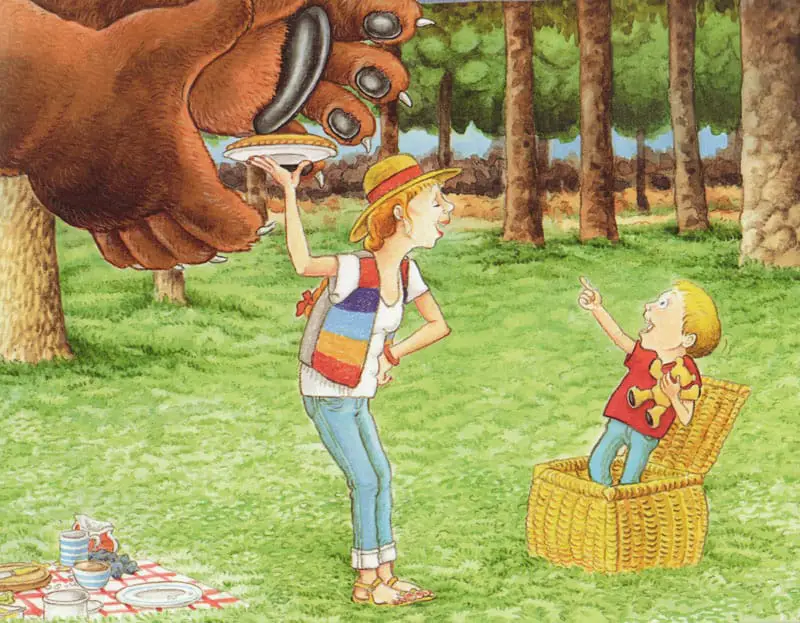
The denouement requires one double page spread, in which Mum and Eddy are sprinting back to the car, and a single page illustration of the very happy bear, who is enjoying the food thrown his way.
RHYMING TEXT
This is a story in which the rhyming text really works. There’s nothing fancy about what’s attempted — Teddy, Eddy, Freddy and ready are an example of words which rhyme; others are dear/here, long/gone, spread/bread, my/pie and so on. Much use is made of capitalisation to give clues about where emphasis should be placed.
IS IT ‘REAL’ OR IS IT ALL IMAGINED?
The detail which will have readers wondering about how much of this happened in ‘the world of the story’ is the detail of the toy bears. Eddy just happens to own the same teddy as the big bear, but in miniature. Readers of the previous book have already been treated to a story in which this coincidence makes the plot.
When adults are drawn into the story, witnessing bizarre events for themselves, then we are to assume that ‘there really is a bear in there’. So the question is answered for us.
NOTES ON THE ILLUSTRATION OF IT’S THE BEAR!
The details of the forest look genuinely pre-digital era and are lavishly detailed. This makes the forest seem alive. Our eyes are drawn into the woods just as Eddy’s are. We should be searching for something inside — just as Eddy does.
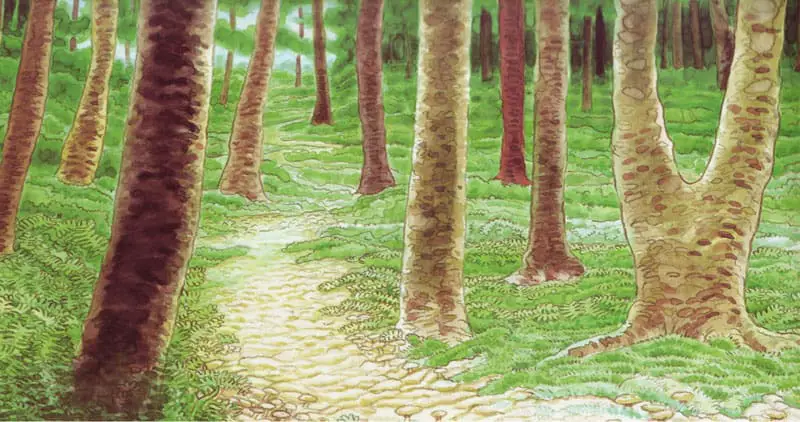
The wonderful detail has been lost in the screen adaptation, with its focus on movement rather than the gaze. However, I’m sure Hayao Miyazaki would have keep the detail and made the most of it.
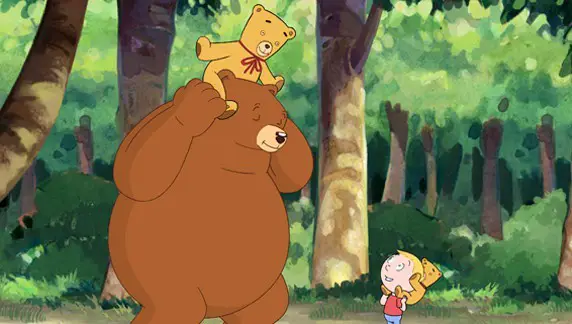
STORY SPECS OF IT’S THE BEAR!
32pp
Published by Candlewick Press
Written and illustrated by Jez Alborough. Alborough has also written picture books about mice, ducks and dogs.
…an English writer and illustrator of children’s picture books that have been translated into at least 15 languages and have been recognised for numerous awards.
Wikipedia
COMPARE IT’S THE BEAR! WITH
When it comes to lavish illustrations of a scary forest, I’m reminded of the illustrations in Anthony Browne’s Hansel and Gretel. In Browne’s story, the reader is rewarded for close examination, because the trees reveal themselves to be ominous shapes.
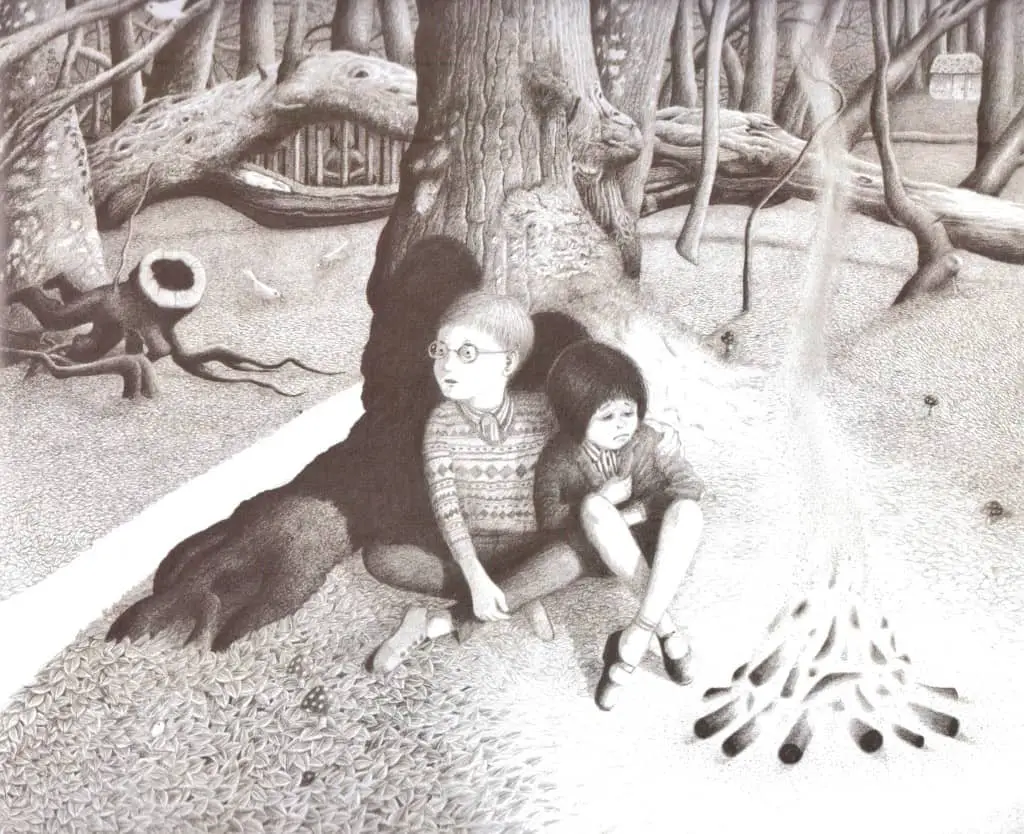
It’s The Bear is interesting also because it plays with scale and proportion — something that seems to appeal very much to young readers. Other things that appeal to young readers are the identification with characters who are separated from their parents, who have imaginations which scare them, and whose toys seem to come to life. Animated toys are common in tales for children.
Different Types Of Toy Stories
In toy stories […] we should probably distinguish between toys existing in a world of their own (notably, doll-house stories, and Winnie-the-Pooh) and toys in contact with a child protagonist. Toys coming alive together with a lonely child may act as substitutes for missing friends, siblings, or even parents.
Maria Nikolajeva, From Mythic to Linear: Time in children’s literature
In the second type of story mentioned above, most toys in toy stories live only when the child is around, being played with. Most of them become worn out or broken and die, but a few go into suspended animation and may come to life generations later into changed worlds.
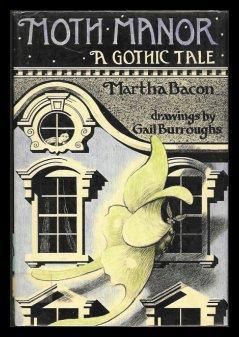
Animal Stories = Toy Stories
[…] There is no point distinguishing between animals stories and toy stories, since both have the same structure, and toy or animal characters share the same function, primarily representing the child. Clearly anthropomorphic animals (such as Beatrix Potter’s or Janosch’s) are especially hard to distinguish from animated toys. Paddington is another good example—the bear is something in-between an animal and a toy (in illustrations, he definitely looks like a teddy-bear) and has the unmistakable function of an “imaginary friend”. […]
There are many marginal cases, like Winnie-the-Pooh, where some characters seem to be more toys, while others are more animals. It is thus arguable whether Winnie-the-Pooh is a toy story or an animal story […] and this may also be a matter of child versus adult perception. For a child reader, the characters of the book are “real,” that is, animals, while adults probably tend to see them as toys.
Maria Nikolajeva, From Mythic to Linear: Time in children’s literature
Why Toy Stories Are Not Their Own Genre
Let us, therefore, not be deceived by the superficial form. Both toys and animals in children’s texts must be seen as representations of children and the texts themselves are, in my text typology, in no way different from domestic stories. When writers present their characters disguised as animals or toys, it is merely a narrative device, which has little to do with genre. There are few similarities between The Jungle Book, Babar and Peter Rabbit, besides their portraying animals; on the other hand, each of them can be related to other books without animals. For instance, The Jungle Book to Robinsonnades, Babar to a sentimental story about an orphan who is finally taken care of (Little Lord Fauntleroy, The Foundling): Peter Rabbit to any didactic naughty-boy book.
Maria Nikolajeva, From Mythic to Linear: Time in children’s literature
Nikolajeva explains that therefore, toy and animal stories are even more heterogenous than “realistic” domestic and school stories.
Animals no doubt are more like us than are dolls, since they are living creatures and dolls are not; but dolls are made in our own image, and in the field of anthropomorphic fantasy there seems no harm in giving them a place. To the children who own them, dolls are people; and often they are people who have a hard life. They are to children as children are to adults: small, powerless beings controlled by others.
John Rowe Townsend, Written For Children
Older Examples Of Stories Featuring Toys
- The Nutcracker
- Pinnochio
- Winnie-the-Pooh
- Miss Hickory by Carolyn Sherwin Bailey (1946)
- Adventures of a Little Wooden Horse
- The Dolls House
- Rufty Tufty the Golliwog
- Five Dolls in a House
- The Mouse and His Child
- The Mennyms series
- Behind The Attic Wall by Sylvia Cassedy (1983)
- Through The Dolls’ House Door by Jane Gardam (1987)
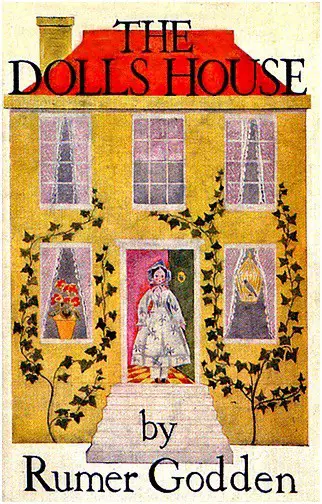
It is an anxious, sometimes a dangerous thing to be a doll. Dolls cannot choose; they can only be chosen; they cannot “do”; they can only be done by; children who do not understand this often do wrong things, and then the dolls are hurt and abused and lost; and when this happens dolls cannot speak, nor do anything except be hurt and abused and lost.
Rumer Godden, The Dolls’ House (1947)
